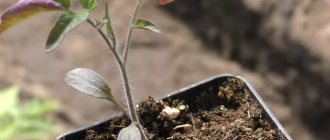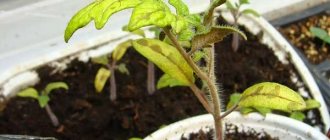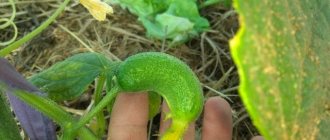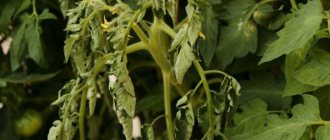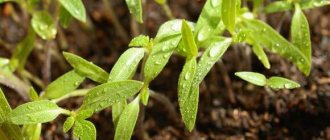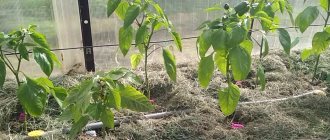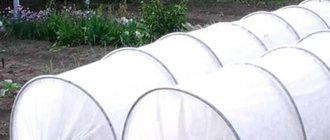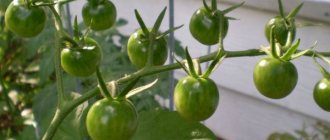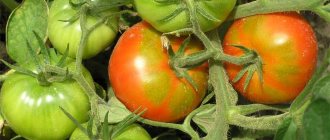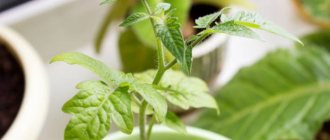Home / Vegetable garden / Tomatoes
Back
Published: 09/14/2020
2
Rate this post
Having sowed tomato seeds in boxes, gardeners eagerly await the first shoots. The baby seedlings are cared for and cared for, carefully creating comfortable conditions for them. And how upset they are when they see that tomato seedlings are not growing well, the bushes stop developing, the leaves turn pale.
The best thing is to prevent problems from arising by following the rules and techniques of agricultural technology. But if you see that the seedlings are weak and do not grow, then you need to immediately identify the reasons and act. In many cases, it is not difficult to correct the situation; it is enough to feed the plants correctly and change the growing conditions.
- 1 Why seedlings do not develop well on the windowsill
- 2 Poor quality soil
- 3 Eating disorders
- 4 Irrigation violations
- 5 Errors in picking
- 6 Diseases of seedlings
- 7 Pests
Why do seedlings grow poorly on a windowsill?
Slow development is caused by a variety of factors. Problems must be considered holistically, taking into account lighting, temperature, soil quality, and growing location.
Tomato seedlings do not grow for the following reasons:
- temperature violation;
- improper watering;
- lack of nutrition;
- poor-quality soil in boxes, containers, pots;
- violations when picking plants;
- cultural diseases;
- pest attack.
Tomatoes are not a picky crop. They respond well to fertilizing, develop quickly on sunny windowsills, and tolerate diving well. But only if everything is done correctly, with care for the seedlings. Any violations will lead to slower growth and development.
On a note! Experienced gardeners always talk to their plants (and not only during the seedling period). According to reviews, such “conversations” have a beneficial effect on the growth of seedlings and contribute to the successful development of culture.
One of the most common reasons for seedlings to stop growing is unsuitable temperature. Tomatoes love warmth, but when growing tomatoes in a window, it should be moderate. Otherwise, the bushes will be weak, stretched out, and if the indicators are too high, they will dry out.
After sowing, containers or boxes are kept at a temperature of +23ºC...+25ºC, then, after the first shoots appear, the indicators are reduced to +16ºC...+18ºC. This is done in order to ensure the correct formation of the plant and prevent the seedlings from stretching.
After 5-7 days, the tomatoes return to warmer conditions:
- daytime temperature +21ºC…+23ºC;
- night +16ºC…+19ºC.
Seedlings do not need excessive heat, nor do they need sudden drops in air. In rooms with heating systems, the air must be humidified and drafts must be avoided when ventilating.
Slow growth of seedlings immediately after germination
When sowing tomatoes for seedlings early, when daylight hours are still very short and there are frosts outside, there is a high probability of very slow growth. This is due to excessively low air temperatures and lack of light. In this case, the seedlings stretch out, become long, thin, grow poorly and do not gain strength.
Experienced gardeners advise in this case to build a mini-greenhouse over the container with seedlings. You also need to install a couple of phytolamps near it. They will allow the plants to receive the right amount of light, and will also warm them.
If the room where the tomatoes are located is very hot, then they should be provided with regular moisture from a sprayer. To do this, use settled water, the temperature of which should be slightly above room temperature.
The substrate in the container is moistened only after its top layer has dried. It is highly not recommended to use tap water for irrigation if it is highly hard. Rain or melt water is best suited for these purposes.
Poor quality soil
The use of low-quality nutrient mixture in seedling boxes often leads to stunted growth. Beginning gardeners often fill containers with soil from the garden or greenhouse. This is incorrect and dangerous, since the soil may contain weed seeds, fungal spores, eggs, and pest larvae.
The soil for tomatoes should be loose, moisture-absorbing, with neutral acidity, with a sufficient amount of nutrients and microelements, while the proportions are strictly observed. Excess nitrogen is no less harmful than deficiency.
If tomatoes grow in poor soil, they will quickly react with slow growth and wilting leaves. Mold, root rot, and an unpleasant odor appear at the base. Seedlings are revived by changing the soil, first disinfecting it with a solution of potassium permanganate or by calcining it in an oven (stove).
A high-quality nutritional mixture consists of:
- humus;
- turf land;
- peat;
- calcined river sand.
Wood ash, dolomite flour, chalk, and leavening agents (vermiculite, perlite) are used as additives.
On a note! When purchasing ready-made mixtures, carefully read the composition. Peat soils must be mixed with other components, adding humus and sand.
How to help a tomato germinate
To get friendly shoots, you need to do this:
- choose fresh, full-bodied seeds with a light shell for sowing;
- keep the old seed in a growth stimulator (Epin, Energen, eloe juice);
- buy special soil for tomatoes in the store or mix humus, garden soil, sand and peat yourself in a ratio of 1:1:1:1;
- observe sowing depth;
- keep the soil moist after sowing.
Advice. Boxes with sown tomatoes until loops appear are covered with a piece of glass or plastic wrap. Under the shelter, a greenhouse effect is created (warm and humid), which has a positive effect on the seedlings.
Loosen the soil
If the soil becomes compacted after sowing, the oxygen content in it decreases. Loosening will help to let air in. Using a wooden toothpick or a pointed match, carefully loosen (pierce the soil many times) the row spacing in the boxes. Loosening depth is 5-9 mm.
See also Rules for growing, description and characteristics of the Nastenka tomato
Treatment of beds with stimulants
In addition to soaking seeds in a solution of stimulants, the same preparations can also be used to water the soil. In this case, the consumption of the nutrient solution will increase, which is not economical.
The most effective means are:
- Energen (30 drops per 1 liter of water);
- Zircon (10 drops per liter);
- Sprout (1 ml or 1 ampoule per 1 liter of water);
- sodium humate (0.3 g per 1 l).
An aqueous solution of drugs is prepared immediately before use. Water the crops once, after watering with clean water.
Expert opinion
Stanislav Pavlovich
Gardener with 17 years of experience and our expert
Ask a Question
Important! You cannot change the dosage of the stimulant yourself, so as not to burn the sprouts.
Eating disorders
In fertile and high-quality soil, tomato seedlings grow quickly. The first sign that something is wrong with the diet is usually the leaves:
- change in color from deep green to pale green, yellow, blanching of the plates, thinning of the shoots - lack of nitrogen;
- the leaves turn blue, “marble” spots form on the plates in the middle - magnesium deficiency;
- redness on the underside – lack of phosphorus;
- the plates curl - the plant lacks potassium.
Also, tomatoes do not grow if there is a lack of iron (leaf chlorosis, stunted growth). Having noticed changes in the color of the seedlings, it is necessary to promptly feed the tomato seedlings.
| Substance | What kind of feeding |
| Nitrogen | Complex fertilizers, urea (4-5 g of fertilizer are diluted per bucket of water) |
| Potassium | Ash (infusion), potassium sulfate (according to instructions) |
| Magnesium | Magnesium sulfate (15 g diluted per 5 liters) |
| Phosphorus | Superphosphate (dilutes 12 g per 10 liters) |
How to determine that seedlings need feeding and what substances are missing
A deficiency of various nutrients leads to a deterioration in the condition of seedlings. Plants begin to wither, become frail, leaves change color, growth stops, etc. Blue, pale, yellow leaves are considered a signal that the plant needs to be fertilized.
Symptoms of nutritional deficiencies:
- Calcium - its deficiency leads to weakened immunity. The main signs are paleness of the leaves, the appearance of stripes and spots.
- Potassium - indicates a decrease in protective forces, increased sensitivity to cold air. The phenomenon is accompanied by the appearance of a bluish tint on the leaves and wrinkles on the edges.
- Copper is an element involved in the processes of photosynthesis and respiration. Copper deficiency manifests itself in changes in the shape of shoots, slower growth, pale leaves, and the appearance of brown spots.
- Iron - takes part in the formation of proteins and chlorophyll. A deficiency of the element is accompanied by yellowing of the leaves and the appearance of green stripes along the veins.
- Chlorine - participates in the development of enzymes responsible for photosynthesis. The lack of substance is accompanied by drooping leaves.
- Phosphorus - energy processes depend on its presence. With a low phosphorus content, yellow veins appear on the leaves, and the lower part of the shoots becomes covered with a pale purple coating.
Errors in picking
Transplanting tomato seedlings from common boxes into separate pots with pinching off part of the root stem is picking, an important procedure when growing seedlings. It promotes the growth of green mass, hardening and strengthening of the root system. But if the tomatoes are not picked correctly, the plants will begin to wither, slow down in growth, or even die.
Why tomatoes grow poorly after picking:
- the procedure time is incorrectly chosen;
- the roots of the seedlings are seriously damaged;
- poor quality soil;
- The seedlings were in bright sun.
How to avoid the problem:
- tomatoes dive when the seedlings have 2-3 true leaves;
- pour high-quality soil mixture into new pots and cups;
- place the seedling in the soil up to the cotyledon leaves;
- control soil moisture after a dive and temperature indicators: +20ºC – during the day, +18ºC at night.
They dive, pinching the root, and also without pinching, simply transplanting the seedlings into spacious containers.
On a note! Pinching the tap root of a plant causes growth retardation for about 8-10 days.
After transplantation, the tomatoes are covered for 2-3 days from bright sunlight, giving time to adapt. Treating plantings with Epin solution helps.
Incorrect timing of sowing seeds
One of the main mistakes gardeners make. When choosing varieties, remember: early tomatoes need to be grown for 50-60 days (with a margin for germination), late tomatoes - 75 days (plus 5-10 days for germination).
| Important. February and March days are short, so early-planted seedlings require 18 hours of additional lighting. |
Without additional lighting, the sprouts will quickly weaken and stretch towards the only, albeit meager, source of light - the sun. The plants will start to get sick and will have to be protected. If you cannot provide the seedlings with additional lighting, you should start sowing later - in April.
April young tomatoes will be underdeveloped by the time they are planted in the ground. But it's better than overgrown seedlings. Later sown tomatoes will produce a harvest just 1-2 weeks later. They will quickly catch up with their February “brothers” and will develop better.
Photo: Weak plants will often get sick and may die.
Seedling diseases
If the above problems of stopping the growth of tomatoes are easy to solve, then diseases are more difficult to fight. Infections are dangerous at any stage, and their appearance on seedlings often leads to plant death.
Most often, growth retardation is caused by:
- blackleg;
- root rot.
They appear when there is a violation of irrigation (excess moisture), too high (greenhouse effect) or low temperatures, or excessive nitrogen content in the soil. One of the causes of the disease is dense plantings and lack of normal ventilation.
Blackleg is a very insidious infection; without surgical treatment, it instantly “mows down” the seedlings. The disease affects tomatoes, peppers, seedlings of flower crops (asters).
What to do:
- in the presence of root rot, replace the soil in containers (pots, glasses), and pre-disinfect the soil. Treat tomatoes with Fitosporin;
- if a black leg is noticed (seedlings with constricted stems, wilting of plants), then change the soil, pour calcined river sand or sifted ash into the boxes, and temporarily stop watering. Spilling the soil with a pink solution of potassium permanganate gives a good effect.
Having noticed a stop in the growth of plants in common boxes due to the black leg, the seedlings are promptly planted, making sure to treat the soil with a solution of potassium permanganate. If the disease is noticed at a late stage, the affected seedlings are removed and burned.
Incorrect temperature
A thermometer is a gardener's best friend. At temperatures above +20 degrees, tomatoes begin to actively grow upward and stretch out. Therefore, it is important to monitor the conditions of their detention.
| Advice. When growing young tomatoes in a window, make a substrate. It will retain heat, protecting the seedlings from the cold windowsill and glass. Otherwise, problems with the root system will appear: the roots will stop developing and begin to rot. |
Photo: Observe temperature conditions.
Pests
Not as often as in greenhouses or garden beds, seedlings are affected by pests. Among them:
- aphid;
- earwig;
- woodlice;
- spider mite.
It happens that pests move to tomatoes from indoor plants when using garden soil. Having noticed cobwebs between the seedlings, dark spots or holes on the leaves, as well as the pests themselves, immediately treat the seedlings with a solution of Actellik or Fitoverm. Treatment with soap solution and ash infusion helps.
Is it difficult to grow healthy and strong tomato seedlings? No, if you follow the basic rules, avoid mistakes and be ready to promptly correct violations. Good luck and great harvests!
Rate this post
Ignoring hardening
At home, plants are in stable conditions. Transplanting into open ground or a greenhouse is stressful for young tomatoes. Therefore, it is important to harden
2-3 weeks before planting in a permanent place, ventilate the room. Without this, there is a high risk of plant death.
___________________________________________________________________________________ Read our other articles about tomato seedlings: Tomato planting calendar in 2022: when to sow tomatoes for seedlings and plant them in the ground How to plant tomatoes: instructions from A to Z for gardeners growing seedlings Tomato seedlings at home: temperature, light, watering and feeding The Chinese way of growing tomato seedlings ___________________________________________________________________________________ How do you care for tomato seedlings? Share tips and reviews with other gardeners in the comments.
Recommendations
To prevent problems with seedlings, you need to take care of a comfortable microclimate for tomatoes and provide them with high-quality, competent care. Not only industrial fertilizers, but also folk remedies can help with this.
- Eggshells – grind the shells of 4-5 eggs to fine crumbs, then add warm water and leave to infuse for 2 days. The result should be a cloudy whitish solution, which is used for watering tomato seedlings. Each seedling will need a teaspoon of egg fertilizer.
- Yeast - mix 5 g of yeast with a teaspoon of granulated sugar, cover and leave to infuse for 24 hours. Apply yeast fertilizer only after pre-watering the seedlings.
- Banana peels are an excellent natural source of potassium for tomato seedlings. To prepare the fertilizer, place the peels of 5 bananas in a glass jar, pour in 3 liters of hot water and leave to infuse for 3 days. Banana fertilizer is applied after irrigating the seedlings.
Slow growth of tomato seedlings is a common problem that even experienced gardeners face. The reasons for poor seedling growth can be different - uncomfortable growing conditions, agrotechnical errors in care or disease. Proper care and favorable conditions will help accelerate the growth of seedlings, increase their immunity and vitality.
Reason #5. Acidity
Quite often, seedlings grow poorly if the soil and its acidity are not suitable for it. It is also worth noting that initially you can choose a suitable substrate, but applying fertilizers and fertilizing will change the acidity, which will lead to the death of the seedlings.
The soil can become very acidic after adding phosphoric acid, carbonammonium salt, some water-soluble fertilizers (for example, Master 18-18-18, Pecasid, MAP and others with an acidity of 1% solution below 3.5 pH), and very alkaline due to lime . This is why you should be very careful when introducing various drugs. Fertilizer applications should be moderate and with a pH of 3.7-6.5 per 1% aqueous solution.
How to solve the problem: pay attention to the acidity of the substrate for tomato seedlings (optimal pH is 5.5-6.5), and if the seedlings are already planted and the soil is not suitable, if possible, dive into another one. You can also select a solution and water the seedlings to neutralize the soil.
